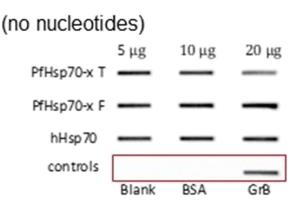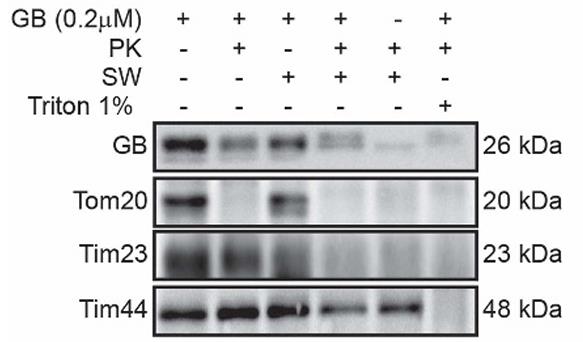GZMB
-
Official Full Name
granzyme B (granzyme 2, cytotoxic T-lymphocyte-associated serine esterase 1) -
Overview
Cytolytic T lymphocytes (CTL) and natural killer (NK) cells share the remarkable ability to recognize, bind, and lyse specific target cells. They are thought to protect their host by lysing cells bearing on their surface nonself antigens, usually peptides or proteins resulting from infection by intracellular pathogens. The protein encoded by this gene is crucial for the rapid induction of target cell apoptosis by CTL in cell-mediated immune response. [provided by RefSeq, Jul 2008] -
Synonyms
GZMB;granzyme B (granzyme 2, cytotoxic T-lymphocyte-associated serine esterase 1);HLP;CCPI;CGL1;CSPB;SECT;CGL-1;CSP-B;CTLA1;CTSGL1;granzyme B;C11;CTLA-1;fragmentin 2;fragmentin-2;cathepsin G-like 1;human lymphocyte protein;T-cell serine protease 1-3E;cytotoxic serine protease B;cytotoxic T-lymphocyte proteinase 2
Recombinant Proteins
- Human
- Mouse
- Rat
- HEK293
- Insect Cells
- Mouse
- Mammalian Cells
- E.coli
- Human Cells
- CHO
- Yeast
- In Vitro Cell Free System
- His
- Non
- Avi
- Fc
- GST
- T7
Background
What is GZMB protein?
GZMB gene (granzyme B) is a protein coding gene which situated on the long arm of chromosome 14 at locus 14q12. This gene encodes a member of the granzyme subfamily of proteins, part of the peptidase S1 family of serine proteases. The encoded preproprotein is secreted by natural killer (NK) cells and cytotoxic T lymphocytes (CTLs) and proteolytically processed to generate the active protease, which induces target cell apoptosis. This protein also processes cytokines and degrades extracellular matrix proteins, and these roles are implicated in chronic inflammation and wound healing. Expression of this gene may be elevated in human patients with cardiac fibrosis. The GZMB protein is consisted of 247 amino acids and GZMB molecular weight is approximately 27.7 kDa.
What is the function of GZMB protein?
GZMB is a serine protease mainly found in cytotoxic T lymphocytes (CTLs) and natural killer (NK) cells. GZMB induces programmed cell death by entering target cells and activating the caspase pathway. GZMB can participate in the induction of inflammation by stimulating the release of cytokines. GZMB is involved in the remodeling of the extracellular matrix and affects the repair and regeneration of tissues. In some cases, GZMB may promote tumor cell proliferation, migration, and epithelial-mesenchymal transformation (EMT) processes, which are associated with tumor progression.
GZMB related signaling pathway
The signaling pathway involved in GZMB is mainly related to its role in cytotoxic T lymphocytes and natural killer cells, which mediate apoptosis of target cells by secreting GZMB. GZMB is able to activate the caspase cascade by cutting multiple substrate proteins, leading to DNA breakage and thereby inducing apoptosis. In addition, GZMB may also be involved in the regulation of cell apoptosis by affecting mitochondrial function and the release of cytochrome C. In tumor immunity, GZMB enhances the immune system's attack on tumor cells by promoting extracellular matrix degradation and proinflammatory effects. The transcriptional regulation mechanism of GZMB involves NF-κB signaling pathway, which plays an important role in the transcriptional regulation of GZMB gene.
GZMB related diseases
GZMB is associated with a variety of diseases, including atherosclerosis, autoimmune skin diseases (e.g., bullous pemphigoid, epidermalysis bullosa, alopecia areata, vitiligo, discoid lupus erythematosus), blood cancers (e.g., acute myelogenous leukemia), inflammatory diseases, and tumors. In these diseases, GZMB plays a role by promoting apoptosis, regulating inflammatory response, influencing extracellular matrix remodeling and other mechanisms, but its role in disease development may have a dual nature, both as a therapeutic target to promote apoptosis and in some cases to promote disease progression.

Fig1. Current understanding of GzmB in cutaneous autoimmune diseases. (Anna Gleave, 2023)
Bioapplications of GZMB
In the field of tumor therapy, the activity of GZMB is closely related to the apoptosis of tumor cells, and its expression level can be used as a biomarker to evaluate the effect of tumor immunotherapy. In addition, GZMB also showed different characteristics in the adaptive immune response of patients with severe and mild COVID-19, revealing its potential role in the viral immune response. In the study of a new mechanism of pyrodeath, GZMB was found to activate Gasdermin B (GSDMB) and enhance anti-tumor immune response, providing a new potential target for tumor therapy.
Case Study
Case Study 1: Lebogang Ramatsui, 2023
Hsp70 (hHsp70) on the surface of human tumor cells enhances the lysis of tumor cells by natural killer (NK) cells through the apoptosis-inducing serine protease granzyme B (GrB). hHsp70 may recruit NK cells to immune synapses via its outer 14-amino acid sequence "TKDNNLLGRFELSG" (TKD motif). Plasmodium infected red blood cells (RBCs) contain hHsp70 and the secretory Plasmodium Hsp70 (PfHsp70-x), both of which have conserved TKD motifs. Although it is unclear whether PfHsp70-x promotes GrB uptake in Plasmodium-infected RBCs, hHsp70 enables GrB to enter tumor cells independently of perforin. In the current study, researchers compared GrB in direct combination with PfHsp70-x or hHsp70. By ELISA, trough blotting, and surface plasmonic resonance (SPR) analysis, results showed that GRBS interact directly with hHsp70 and PfHsp70-x, and have a higher affinity for PfHsp70-x. In addition, the TKD motifs of PfHsp70-x interact directly with GRBS, while the EEVN motifs at the C-terminus enhance this affinity but are not necessary for binding. GrB also demonstrated strong antimalarial activity (IC50 of 0.5 microns).

Fig1. The interaction of the three Hsp70s with GrB was investigated in the absence of nucleotides.

Fig2. The assay was repeated to explore the interaction of the respective TKD motifs of the Hsp70s with GrB.
Case Study 2: Valentina Chiusolo, 2017
This study found that granzyme B (GB) -induced apoptosis also requires reactive oxygen species from changes in mitochondrial complex I. How GB without mitochondrial localization sequences enters this organelle is unclear. GB translocase complex enters the mitochondria independently of the outer membrane and instead requires Sam50, which is the central subunit of the sequencing and assembly machinery that integrates the outer membrane β-barrel proteins. In addition, GB penetrates the inner membrane through Tim22, a metabolite carrier translocation pore, in a manner dependent on mitochondrial heat shock protein 70 (mtHsp70). Granzyme A (GA) and caspase-3 also use a similar pathway to enter the mitochondria. Finally, blocking GB from entering the mitochondria by mutating GB's lysine 243 and arginine 244 or depleting Sam50 can make cells more resistant to GB-mediated reactive oxygen species and cell death. Similarly, Sam50 depletion also protects cells from GA, GM, and Caspase-3-mediated cell death.

Fig3. Freshly purified yeast mitochondria were incubated or not with GB in import buffer.

Fig4. Purified wtGB or KR243/244AA GB showed similar specific activity when tested against a GB colorimetric substrate.
Quality Guarantee
High Purity
.jpg)
Fig1. SDS-PAGE (GZMB-33H)
.
.jpg)
Fig2. SDS-PAGE (GZMB-35H)
Involved Pathway
GZMB involved in several pathways and played different roles in them. We selected most pathways GZMB participated on our site, such as Natural killer cell mediated cytotoxicity,Type I diabetes mellitus,Transcriptional misregulation in cancer, which may be useful for your reference. Also, other proteins which involved in the same pathway with GZMB were listed below. Creative BioMart supplied nearly all the proteins listed, you can search them on our site.
| Pathway Name | Pathway Related Protein |
|---|---|
| Graft-versus-host disease | FAS,HLA-DRB3,IL1A,HLA-B,HLA-DRB5,H2-AB1,HLA-DQB1,HLA-C,KIR2DL3,IL6 |
| Type I diabetes mellitus | HLA-DRB4,CD80,PTPRN,CPE,HLA-F,HLA-DMB,IL1A,IFNG,HLA-G,HLA-A |
| Transcriptional misregulation in cancer | RXRG,PML,NGFR,PBX1,LDB1,TRAF1,FCGR1,ELK4,DEFA3,BIRC3 |
| Natural killer cell mediated cytotoxicity | FASLG,GRB2,ICAM2,KIR2DL3,HLA-A,KLRA8,LAT,TNFRSF10A,IFNA2,KLRC2 |
| Allograft rejection | HLA-DMA,IL12A,HLA-E,Il2,H2-AA,HLA-DRB4,HLA-A,IL12B,IL5,CD40 |
| Autoi | HLA-G,IFNA17,Il2,IFNA10,CD40,HLA-C,IFNA8,Ifna11,PRF1,TSHB |
| ne thyroid disease | CD86,HLA-DQA2,Il2,IFNA1,IFNA21,HLA-DOB,Fasl,Ifna11,IFNA7,HLA-DPB1 |
Protein Function
GZMB has several biochemical functions, for example, protein binding,serine-type endopeptidase activity,serine-type peptidase activity. Some of the functions are cooperated with other proteins, some of the functions could acted by GZMB itself. We selected most functions GZMB had, and list some proteins which have the same functions with GZMB. You can find most of the proteins on our site.
| Function | Related Protein |
|---|---|
| protein binding | CCDC108,TMX3,PRPF19,SLC14A2,ACTB,EDF1,LMNA,RAB39B,CDC37L1,AP3S1 |
| serine-type peptidase activity | PARLA,ELA2L,TPP1,DPP4,KLK1B11,GZMC,TRY,TMPRSS11B,TMPRSS4A,ENDOU |
| serine-type endopeptidase activity | C1RL,TPP2,PRSS59.1,PCSK1,PROC,GZMK,CFI,C2,TMPRSS15,KLK1B22 |
Interacting Protein
GZMB has direct interactions with proteins and molecules. Those interactions were detected by several methods such as yeast two hybrid, co-IP, pull-down and so on. We selected proteins and molecules interacted with GZMB here. Most of them are supplied by our site. Hope this information will be useful for your research of GZMB.
SRGN;FN1;DBP;ELANE;PRF1;EEA1
Resources
Related Services
Related Products
References
- Mrizak, D; Martin, N; et al. Effect of Nasopharyngeal Carcinoma-Derived Exosomes on Human Regulatory T Cells. JNCI-JOURNAL OF THE NATIONAL CANCER INSTITUTE 107:-(2015).
- Metkar, SS; Marchioretto, M; et al. Perforin oligomers form arcs in cellular membranes: a locus for intracellular delivery of granzymes. CELL DEATH AND DIFFERENTIATION 22:74-85(2015).



